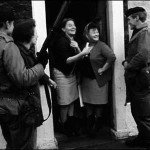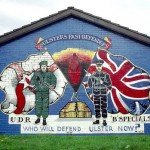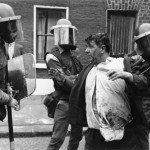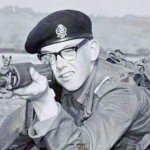
Operation Banner was the deployment of British soldiers in Northern Ireland. This action was considered as early as 1966 when violence erupted between the newly formed Ulster Volunteer Force (UVF) and armed Republicans. There was also talk of introducing the military in late 1968, as the Royal Ulster Constabulary (RUC) and ‘B-Specials’ struggled to contain civil rights protests and the sectarian violence that followed. The British government and British army commanders were, by all accounts, reluctant to put troops on the ground in Northern Ireland. Two Northern Ireland prime ministers, Terence O’Neill and James Chichester-Clark, also resisted the urge to request military assistance; to do so would be a sign their governments had lost control of the situation. But when rioting, violence and gun fighting erupted in the Bogside area of Derry in August 1969, then spread to other locations in Northern Ireland, it stretched the RUC dangerously thin. Left with no alternative, Chichester-Clark petitioned London to send in troops. This request was made on August 14th and noted in British cabinet records:
“The Cabinet Security Committee authorised a formal request for the use of troops in aid of the civil power in Londonderry at 4.45pm, in view of the latest police reports indicating their inability to cope with a rapidly deteriorating situation.”
A period of hope
The arrival of British troops was welcomed by many Catholics, at least initially. Residents in Derry, Belfast and other troubled areas believed that British soldiers would act with greater caution and neutrality than RUC officers or the thuggish ‘B Specials’. Some Catholics even cheered and applauded British soldiers, or offered them cups of tea. Other developments also inspired hope. On August 28th 1969 a British lieutenant general, Ian Freeland, took charge of security matters, removing these powers from Stormont and the RUC. British Home Secretary James Callaghan twice visited Belfast to meet with government representatives. On his first visit in late August Callaghan issued a communique, promising to oversee sweeping reforms and protections for civil rights. In September the British Army began erecting the first ‘peace line’, a high wall separating Catholic and Protestant areas in Belfast. The Cameron Report on disorders in Northern Ireland in late 1968 and early 1969 was also published in September. This report vindicated the Catholic community’s complaints about discrimination and police heavy-handedness, finding examples of “unnecessary and ill-controlled force in the dispersal of the demonstrators”. There was also a separate inquiry, overseen by Baron Hunt, into the structure and organisation of Northern Ireland’s civilian police service.

In October 1969 the Hunt Report made a series of recommendations on security and policing. Hunt recommended the dissolution of the ‘B Specials’, a suggestion that was passed into law and finalised in March 1970. A replacement force, the Ulster Defence Regiment (UDR), was formed on January 1st 1970 and began operations three months later. The UDR was a reservist security force but was intended to be well trained and non-sectarian. Hunt recommended the UDR recruit Protestants and Catholics in similar proportions – but the regiment failed to attract and retain sufficient numbers of Catholics. In the regiment’s first year only 18 per cent of its rank and file were Catholic; the vast majority of its first recruits were Protestant and a good number of these (more than 1,400) were former ‘B Specials’. There were attempts to integrate Catholics into the UDR but the regiment was dominated by Protestants. As a consequence, it was dominated by Unionist culture and political values. Some Catholics in the UDR reported both open and subtle intimidation by Protestants. Others were discouraged by actions such as the Falls curfew, internment and Bloody Sunday, which convinced many that security forces were targeting Catholics. By 1972, most viewed the UDR as a bulwark of Protestantism and Loyalism. Disillusioned Catholics abandoned the UDR and by 1975 fewer than four per cent of its members were Catholic.
The relationship deteriorates

The honeymoon between Northern Ireland’s civilian population and the British military lasted but a few weeks. The Army’s attempts to win over Catholic communities were undermined by its responses to civil disorder, which tended to be militaristic and heavy-handed. In April 1970 violence erupted in Ballymurphy, a desperately poor housing estate in western Belfast, after an Orange Order parade passed close to the fringes of the estate. Catholic youths clashed with Loyalists and a British company was sent into Balllymurphy to quell the violence. When the soldiers themselves were pelted with stones, they responded by firing canisters of CS gas. This gas flooded the estate and affected thousands of residents not involved in the rioting. According to British journalist Simon Winchester, the use of tear gas at Ballymurphy “welded the crowd together in common sympathy and a common hatred for the men who gassed them”. In July 1970 the Army, frustrated by rising gun violence, swept into the Lower Falls, a Catholic stronghold in west Belfast. Soldiers locked down an area of 50 streets, imposed a curfew and launched a house-to-house search for weapons. Tipped off earlier, the Irish Republican Army (IRA) had cleared the area of arms and personnel so the soldiers found little. The searches triggered clashes between residents and soldiers, as well as some violence. Five people were shot dead while others were injured by gunfire or CS gas. The Army’s image as peacekeeper and protector of Catholic civilians was significantly damaged.
“Their appearance was clear proof that we had won the battle, that the RUC was beaten. That was welcomed. But there was confusion as to what the proper attitude to the soldiers might be. It was not in our history to make British soldiers welcome.”
Eamonn McCann, writer
It should be noted that many Catholics opposed British military intervention from the outset. Moderate Nationalists objected to Operation Banner because it militarised their society and exposed their children to troops on a regular basis. They condemned it as a flawed solution, a foreign military response to an Irish civil problem. Republicans, of course, opposed any form of British presence in Northern Ireland, whether political or military. They viewed the British Army as a foreign imperialist force, deployed to enforce British sovereignty and prop up the floundering Stormont government. A militant faction of the Irish Republican Army (IRA) began calling for an all-out war against British soldiers, a tactic rejected by the IRA’s mainstream leaders. In late 1969 these radicals split from the ‘official’ IRA, later becoming known as the Provisional IRA. Through 1970 the Provisional IRA recruited members, attacked the “British occupation” with rhetoric and propaganda and sought to win support from Catholic civilians. Young IRA volunteers also provoked civil unrest and violence, such as the April 1970 Ballymurphy riots. Their tactic was to trigger a disproportionate military response from the British; this would poison civilian attitudes towards the British Army and drive Catholics towards the IRA. The Provisional IRA stopped short of killing British soldiers, however. As Sinn Fein leader Danny Morrison noted, it was too early for such a tactic: “They couldn’t have sold it”.
The Provisional IRA declares war

By the beginning of 1971, the Provisional IRA was ready to declare war on the British Army in Northern Ireland. Its first victim was Robert Curtis, a 20-year-old soldier. Curtis was gunned down by a sniper on February 6th, while on foot patrol on New Lodge Road. Before the month was out the ‘Provos’ had killed another British soldier, two RUC officers and five civilians working for the BBC. These events triggered the resignation of prime minister James Chichester-Clark in March 1971; he was replaced by Brian Faulkner. The new prime minister made some attempt at reconciliation, promoting a non-Unionist to his cabinet, appointing a Catholic as minister of state and offering Nationalists key roles in government committees. Most of Faulkner’s attention was on security, however, and the increasing volume and ferocity of paramilitary violence from the Provisional IRA. The British Army’s image was finally shattered in January 1972, when British paratroopers opened fire on a protest in Derry, killing 14 people. The first investigation into ‘Bloody Sunday’ was corrupt and inept in equal measure; the Army refused to admit fault and was not held to account for the actions of its members. ‘Bloody Sunday’ only widened the gulf between British security forces and Catholic civilians. Eighteen months into Operation Banner, British soldiers were enmeshed in a hornet’s nest of sectarian hatred and deadly paramilitary warfare, with no possibility of victory and no clear avenue for withdrawal. The worst, however, was yet to come.

1. Operation Banner was the deployment of British Army soldiers in Northern Ireland, to assist local police and help keep the peace. This operation began on August 14th 1969.
2. Operation Banner was intended to be temporary. British strategists hoped to restore order by winning the trust of Catholics while reforming Northern Ireland’s security measures.
3. One reform was the abolition of the ‘B Specials’ and the formation of the UDR. The UDR was intended to be non-sectarian but like the RUC came to be dominated by Protestants.
4. The Army’s tactical response to the Ballymurphy riots, the Falls curfew and ‘Bloody Sunday’ all alienated Catholics, who felt they were being targeted and persecuted.
5. The presence of British soldiers in Northern Ireland also produced a split in the IRA. One faction determined to take stronger action against the soldiers evolved into the Provisional IRA.

BBC News: British troops deployed in Northern Ireland (August 1969)
Soldier (Harvey Andrews song, 1972)
The British Army issues new instructions on opening fire without warning (March 1973)
’71 (2014 movie)
© Alpha History 2018. Content on this page may not be republished or distributed without our express permission. For more information please refer to our Terms of Use.
This page was written by Rebekah Poole and Jennifer Llewellyn. To reference this page, use the following citation:
R. Poole and J. Llewellyn, “Operation Banner: the British Army in Northern Ireland”, Alpha History, accessed [today’s date], https://alphahistory.com/northernireland/operation-banner/
